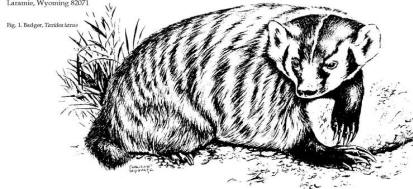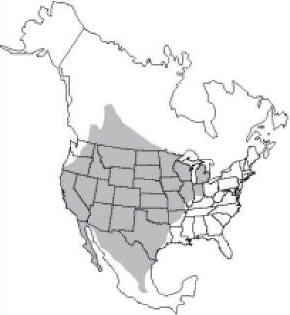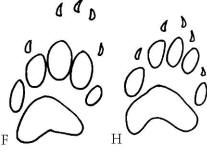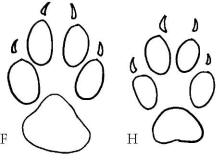|
|
|
|
 |
CARNIVORES: Badgers |
|
|

Identification
The badger (Taxidea
taxus) is a stocky, medium-sized mammal with a broad
head, a short, thick neck, short legs, and a short,
bushy tail. Its front legs are stout and muscular, and
its front claws are long. It is silver-gray, has long
guard hairs, a black patch on each cheek, black feet,
and a characteristic white stripe extending from its
nose over the top of its head. The length of this stripe
down the back varies. Badgers may weigh up to 30 pounds
(13.5 kg), but average about 19 pounds (8.6 kg) for
males and 14 pounds (6.3 kg) for females. Eyeshine at
night is green.
 Fig.
2. Range of the badger in North America. Fig.
2. Range of the badger in North America.
Range
The badger is widely
distributed in the contiguous United States. Its range
extends southward from the Great Lakes states to the
Ohio Valley and westward through the Great Plains to the
Pacific Coast, though not west of the Cascade mountain
range in the Northwest (Fig. 2). Badgers are found at
elevations of up to 12,000 feet (3,600 m).
Habitat
Badgers prefer open
country with light to moderate cover, such as pastures
and rangelands inhabited by burrowing rodents. They are
seldom found in areas that have many trees.
Food
Habits
Badgers are opportunists,
preying on ground-nesting birds and their eggs, mammals,
reptiles, amphibians, and insects. Common dietary items
are ground squirrels, pocket gophers, prairie dogs, and
other smaller rodents. Occasionally they eat vegetable
matter. Metabolism studies indicate that an average
badger must eat about two ground squirrels or pocket
gophers daily to maintain its weight. Badgers may
occasionally kill small lambs and young domestic
turkeys, parts of which they often will bury.
General Biology, Reproduction, and Behavior
Badgers are members of the
weasel family and have the musky odor characteristic of
this family. They are especially adapted for burrowing,
with strong front legs equipped with long,
well-developed claws. Their digging capability is used
to pursue and capture ground-dwelling prey. Typical
burrows dug in pursuit of prey are shallow and about 1
foot (30 cm) in diameter. A female badger will dig a
deeper burrow (5 to 30 feet long [1.5 to 9 m]) with an
enlarged chamber 2 to 3 feet (0.6 to 0.9 m) below the
surface in which to give birth. Dens usually have a
single, often elliptical entrance, typically marked by a
mound of soil in the front.
Badgers have a rather
ferocious appearance when confronted, and often make
short charges at an intruder. They may hiss, growl, or
snarl when fighting or cornered. Their quick movements,
loose hide, muscular body, and tendency to retreat
quickly into a den provide protection from most
predators. Larger predators such as mountain lions,
bears, and wolves will kill adult badgers. Coyotes and
eagles will take young badgers.
Badgers are active at
night, remaining in dens during daylight hours, but are
often seen at dawn or dusk. During winter they may
remain inactive in their burrows for up to a month,
although they are not true hibernators. Male badgers are
solitary except during the mating season, and females
are solitary except when mating or rearing young.
Densities of badgers are reported to be about 1 per
square mile (0.4/km 2) although densities as high as 5
to 15 badgers per square mile (1.9 to 5.8/km2) have been
reported. An adult male’s home range may be as large as
2.5 square miles (6.5 km2); the home range of adult
females is typically about half that size. Badgers may
use as little as 10% of their range during the winter.
Badgers breed in summer
and early fall, but have delayed implantation, with
active gestation beginning around February. Some
yearling females may breed, but yearling males do not.
As many as 5 young, but usually 2 or 3, are born in
early spring. Young nurse for 5 to 6 weeks, and they may
remain with the female until midsummer. Most young
disperse from their mother’s range and may move up to 32
miles (52 km). Badgers may live up to 14 years in the
wild; a badger in a zoo lived to be 15 1/2 years of age.
Damage and Damage Identification
Most damage caused by
badgers results from their digging in pursuit of prey.
Open burrows create a hazard to livestock and horseback
riders. Badger diggings in crop fields may slow
harvesting or cause damage to machinery. Digging can
also damage earthen dams or dikes and irrigation canals,
resulting in flooding and the loss of irrigation water.
Diggings on the shoulders of roads can lead to erosion
and the collapse of road surfaces. In late summer and
fall, watch for signs of digging that indicate that
young badgers have moved into the area.
Badgers will occasionally
prey on livestock or poultry, gaining access to
protected animals by digging under fences or through the
floor of a poultry house. Tracks can indicate the
presence of badgers, but to the novice, badger tracks
may appear similar to coyote tracks (see Coyotes ). Claw
marks are farther from the toe pad in badger tracks,
however, and the front tracks have a pigeon-toed
appearance (Fig. 3).
Badgers usually consume
all of a prairie dog except the head and the fur along
the back. This characteristic probably holds true for
much of their prey; however, signs of digging near the
remains of prey are the best evidence of predation by a
badger. Because badgers will kill black-footed ferrets,
their presence is of concern in reintroduction programs
for this endangered species.


BADGER
COYOTE TRACK
Fig. 3. Badger tracks
compared to coyote tracks.
Legal Status
In some states, badgers
are classified as furbearers and protected by regulated
trapping seasons, while in other states they receive no
legal protection. Contact your state wildlife agency
before conducting lethal control of badgers.
Damage Prevention and Control Methods
Exclusion
Mesh fencing buried to a depth of 12 to 18 inches
(30 to 46 cm) can exclude most badgers. The cost and
effort to construct such fences, however, preclude their
use for large areas.
Habitat Modification
Control of rodents, particularly burrowing rodents,
offers the greatest potential for alleviating problems
resulting from badger diggings. For example, controlling
ground squirrels or pocket gophers in alfalfa fields
will likely result in badgers hunting elsewhere.
Frightening
Badgers may be discouraged from a problem area by
the use of bright lights at night. High-intensity lamps
used to light up a farmyard may discourage badger
predation on poultry.
Trapping
Badgers can be removed by using live traps and/or
foothold traps set like those for coyotes (see Coyotes).
Snares have been used with mixed success. Badgers often
return to old diggings. A good bait for badgers is a
dead chicken placed within a recently dug burrow. Fur
trapping may reduce badger populations locally, but
badger pelts are generally of little value and most
badgers are caught incidentally.
Foothold traps (No. 3 or
4) are adequate to hold a badger. Rather than staking
the trap to the ground, it is better to attach it to a
drag such as a strong limb or similar object that the
badger cannot pull down into its burrow. Badgers will
often dig in a circle around a stake, sometimes enough
to loosen the stake and drag the trap away.
Shooting
Badgers can be controlled by shooting. Spotlighting,
if legal, can be effective. Incidental shooting has
contributed to reducing their numbers in some areas.
Acknowledgments
This chapter is a revision
of the chapter on badgers by Norman C. Johnson in the
1983 edition of Prevention and Control of Wildlife
Damage. F. Robert Henderson and Steve Minta provided
information included in this chapter.
Figures 1 and 2 from
Schwartz and Schwartz (1981).
Figure 3 from Wade (1973).
For Additional Information
Hawthorne, D. W. 1980.
Wildlife damage and control techniques. Pages 411-439 in
S. D. Schemnitz, ed. Wildlife management techniques
manual. The Wildl. Soc., Washington, DC.
Lindzey, F. C. 1982.
Badger. Pages 653-663 in J. A. Chapman and G. A.
Feldhamer, eds. Wild mammals of North America: biology,
management, and economics. The Johns Hopkins Univ.
Press, Baltimore, Maryland.
Long, C. A. 1973. Taxidea
taxus . Mammal. Spec. 26:1-4.
Messick, J. P. 1987. North
American badger. Pages 584-597 in M. Novak, J. A. Baker,
M. E. Obbard, and B. Malloch, eds. Wild furbearer
management and conservation in North America. Ontario
Ministry of Nat. Resour.
Minta, S. C., and R. E.
Marsh. 1988. Badgers ( Taxidea taxus ) as occasional
pests in agriculture. Proc. Vertebr. Pest. Conf.
13:199-208.
Sargeant, A. B., and D. W.
Warner. 1972. Movements and denning habits of a badger,
J. Mammal. 53:207-210.
Schwartz, C. W., and E. R.
Schwartz. 1981. The wild mammals of Missouri, rev. ed.
Univ. Missouri Press, Columbia. 356 pp.
Wade, D. A. 1973. Control
of damage by coyotes and some other carnivores. Coop.
Ext. Serv. Pub. WR P-11, Colorado State Univ., Fort
Collins. 29 pp.
Wade, D. A., and J. E.
Bowns. 1982. Procedures for evaluating predation on
livestock and wildlife. Bull. B-1429, Texas A & M Univ.
System, College Sta., and the US Fish Wildl. Serv. 42
pp.
Editors
Scott E. Hygnstrom Robert
M. Timm Gary E. Larson
PREVENTION AND CONTROL OF
WILDLIFE DAMAGE — 1994
Cooperative Extension
Division Institute of Agriculture and Natural Resources
University of Nebraska -Lincoln
United States Department
of Agriculture Animal and Plant Health Inspection
Service Animal Damage Control
Great Plains Agricultural
Council Wildlife Committee
03/28/2007
Special
thanks to:
Clemson University
James E. Miller
Program Leader, Fish and Wildlife
USDA — Extension Service Natural Resources and Rural
Development Unit
Washington, DC 20250
|